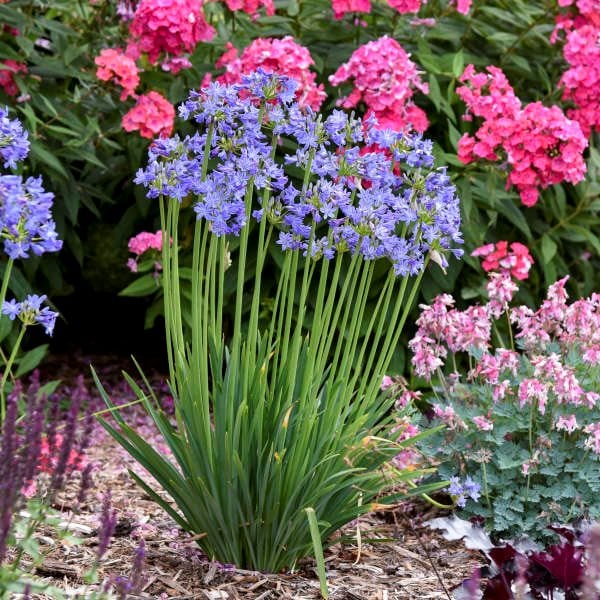Grasping the Art of Agapanthus Treatment: Essential Steps for Healthy And Balanced Growth and Dynamic Blooms
In the world of cultivation, the growing of agapanthus stands as a fulfilling undertaking for those who look for to support these stylish blooming plants. With their striking blossoms and stylish foliage, agapanthus has recorded the interest of garden enthusiasts worldwide. However, attaining optimum growth and vibrant blooms requires a nuanced strategy that encompasses numerous vital steps. From selecting the appropriate selection to grasping trimming techniques, the trip towards growing growing agapanthus plants is complex and holds the key to opening the complete capacity of these botanical treasures.

Picking the Right Agapanthus Variety

When selecting the ideal Agapanthus selection for your yard, consider factors such as environment viability, flower color, and development practice. In addition, take into consideration the environment in your region to make sure the Agapanthus variety you pick can prosper in your certain problems. Recognizing the development behavior of various Agapanthus ranges is important for appropriate positioning within your yard.
Perfect Growing Conditions
Thinking about the optimal environmental requirements is crucial for effective Agapanthus farming. Agapanthus thrives in well-draining dirt with a somewhat acidic to neutral pH level. When planting, pick a location that obtains complete sunlight to partial color. In hotter environments, supplying some afternoon color can protect against scorching of the fallen leaves. Agapanthus plants are delicate to cold temperature levels and need to be protected from frost during winter season.
To make certain healthy development and vivid blooms, plant Agapanthus bulbs at a depth of regarding 2-4 inches and room them 8-12 inches apart. Mulching around the base of the plants helps keep wetness and suppresses weed development.
Watering and Feeding Tips
Maintaining proper wetness levels and offering vital nutrients are vital components in the care routine for Agapanthus plants. When it comes to sprinkling Agapanthus, it is critical to strike an equilibrium. These plants prefer regularly wet dirt but are prone to root rot if overwatered.
Feeding Agapanthus is necessary for advertising healthy growth and prolific flowers. Apply a balanced fertilizer, such as a 10-10-10 formula, in the early spring as brand-new growth emerges. By complying with these discover this watering and fertilizing pointers, you can ensure your Agapanthus plants prosper and create lively, durable blossoms.
Trimming Strategies for Agapanthus
Pruning Agapanthus plants at the appropriate times and with correct techniques is important for maintaining their wellness and advertising optimal development and blooming. The optimal time to trim Agapanthus remains in late winter months or early spring prior to new development emerges. Begin by removing any dead or yellowing leaves near the base of the plant. Cut them as close to the ground as possible without damaging the emerging shoots.
For flowered stems, wait up until the blossoms have perished and after that cut them back to the base. This not just cleans the plant's appearance yet likewise urges the development of new flower buds. Deadheading invested blossoms can likewise redirect the plant's energy right into producing more flowers instead than establishing seeds. Nonetheless, if you wish to gather seeds for breeding, leave some blossoms to fully grown and completely dry on the plant.
Bear in mind to make use of tidy, sharp tools to make specific cuts and reduce the risk of presenting diseases. Agapanthus. Normal trimming will aid keep your Agapanthus looking neat and healthy while making certain a plentiful display of lovely flowers
Managing Common Pests and Diseases
After guaranteeing correct trimming techniques for Agapanthus, it is vital to deal with typical parasites and diseases that can influence the wellness and vitality of these plants. Agapanthus plants are normally hardy however can still come down with specific concerns. One common insect that impacts Agapanthus is the Agapanthus gall midget. This little, orange fly lays its eggs in the vegetation, causing distorted growth and blossom buds that fail to open up. To combat this bug, prune and ruin any type of afflicted plant parts and consider making use of read more insecticidal soap. my link
In addition, Agapanthus plants can endure from origin rot if they are planted in inadequately draining soil. By being vigilant and taking prompt action against pests and illness, you can help your Agapanthus plants grow and produce vibrant blooms. Agapanthus.

Conclusion
Finally, grasping the art of agapanthus care involves selecting the ideal range, providing perfect planting conditions, proper watering and feeding, proper pruning strategies, and dealing with typical parasites and illness. By complying with these necessary steps, you can ensure healthy development and vibrant blossoms for your agapanthus plants. Keep in mind to on a regular basis monitor and maintain your plants to promote their total wellness and durability.
To ensure healthy and balanced development and dynamic blossoms, plant Agapanthus light bulbs at a deepness of concerning 2-4 inches and area them 8-12 inches apart. By following these watering and fertilizing ideas, you can guarantee your Agapanthus plants thrive and generate dynamic, resilient flowers.
One common parasite that affects Agapanthus is the Agapanthus gall midget. In addition, Agapanthus plants can experience from origin rot if they are planted in badly draining soil. By adhering to these important actions, you can make sure healthy and balanced growth and lively blooms for your agapanthus plants.